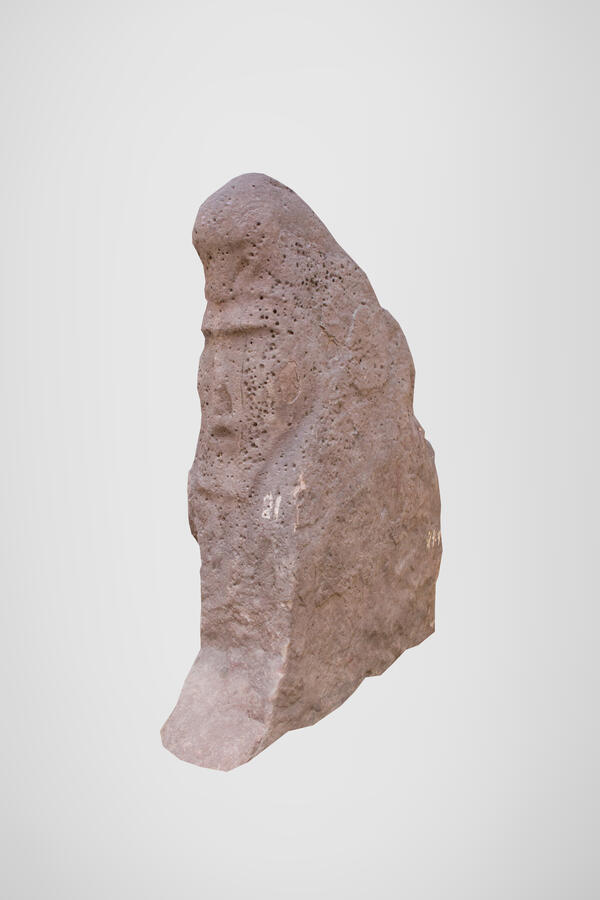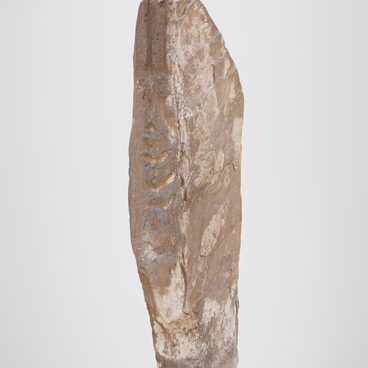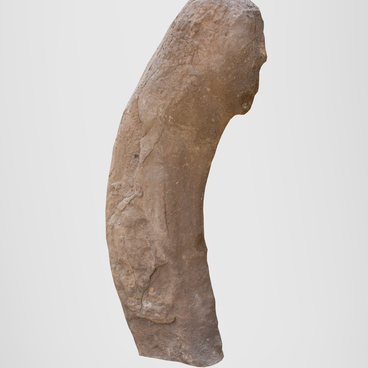This stela of Devonian sandstone was found in 1949 by the ethnographer and archaeologist Albert Lipsky at the mouth of the Khir-chola ravine. This long, deep ravine is located near the Beltira ulus on the left bank of the Abakan River in the Askiz district of Khakassia. In 1953, Lipsky transported the stela along with other statues to the Khakass Regional Museum of Local History.
The stela “Khys-kyoze” belongs to the Okunev archaeological culture of the late 3rd — early 2nd millennium BC. Later it was used as an outrigger stela from the southwestern side of the Tagar mound. The Tagar archaeological culture of the Minusinsk Basin fell within the 8th-3rd centuries BC; its characteristic feature is the construction of impressive mounds.
“Khys-kyoze” in Khakass means a “stone girl” or a “girl-menhir”. Menhir is a roughly worked and man-made stone block, the height of which is greater than the width.
On the narrow edge of the stela, the ancient master carved an anthropomorphic, or humanoid, face of a deity. Due to the fact that he carefully polished the details of the image, the mask looks like it protrudes from the stone. In the upper part, he highlighted the strongly protruding superciliary arches, which hang like a roller over the closed eyes. The nose is highlighted on the stela, it starts from the eyebrows. On the sides of the nose, a resurfacing was made, which emphasizes the relief of the cheekbones. In the lower part, the master placed an oval mouth in the form of a solid depression, and made the lower jaw square.
The top of the statue, according to archaeologist Leonid Kyzlasov, has the shape of a ram’s head, the end of the muzzle of which hangs over the anthropomorphic face located below. In the Okunev sacrificial rituals, rams occupied an important place: the skins of lambs with a skull and hooves are found under ancient statues and menhirs of this culture, and the bones of rams are among the stones of the Okunev altars. In addition, some of the stelae of the Okunev culture are also decorated with a pommel in the shape of a ram’s head.
According to another version, expressed by the researchers, this is a headband in the form of a bird’s head. Drawings depicting the figures of deities with the head of a bird of prey are found on slabs from the Tas-Khaza mound, which translates from Khakass as a “stone courtyard”. This version is supported by the thin lines extending from the head of the pommel: they resemble hair slicked back. It is believed that these lines are rays that are found in Okunev art in figures that combine the features of a person and a bird.
The stela “Khys-kyoze” belongs to the Okunev archaeological culture of the late 3rd — early 2nd millennium BC. Later it was used as an outrigger stela from the southwestern side of the Tagar mound. The Tagar archaeological culture of the Minusinsk Basin fell within the 8th-3rd centuries BC; its characteristic feature is the construction of impressive mounds.
“Khys-kyoze” in Khakass means a “stone girl” or a “girl-menhir”. Menhir is a roughly worked and man-made stone block, the height of which is greater than the width.
On the narrow edge of the stela, the ancient master carved an anthropomorphic, or humanoid, face of a deity. Due to the fact that he carefully polished the details of the image, the mask looks like it protrudes from the stone. In the upper part, he highlighted the strongly protruding superciliary arches, which hang like a roller over the closed eyes. The nose is highlighted on the stela, it starts from the eyebrows. On the sides of the nose, a resurfacing was made, which emphasizes the relief of the cheekbones. In the lower part, the master placed an oval mouth in the form of a solid depression, and made the lower jaw square.
The top of the statue, according to archaeologist Leonid Kyzlasov, has the shape of a ram’s head, the end of the muzzle of which hangs over the anthropomorphic face located below. In the Okunev sacrificial rituals, rams occupied an important place: the skins of lambs with a skull and hooves are found under ancient statues and menhirs of this culture, and the bones of rams are among the stones of the Okunev altars. In addition, some of the stelae of the Okunev culture are also decorated with a pommel in the shape of a ram’s head.
According to another version, expressed by the researchers, this is a headband in the form of a bird’s head. Drawings depicting the figures of deities with the head of a bird of prey are found on slabs from the Tas-Khaza mound, which translates from Khakass as a “stone courtyard”. This version is supported by the thin lines extending from the head of the pommel: they resemble hair slicked back. It is believed that these lines are rays that are found in Okunev art in figures that combine the features of a person and a bird.



